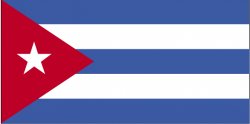Flag of Cuba

The flag of Cuba was adopted on 1848, containing a field with three blue stripes and two white stripes, and a red equilateral triangle at the hoist with a white 5-pointed star.
The Cuban flag was created by Narciso López in June 25, 1848, and put together by Emilia Teurbe Tolón. The flag's origins date from 1848, when various movements to liberate Cuba from Spanish rule emerged, mainly among Cuban exiles in the United States. Anti-Spanish Cuban exiles under the leadership of Narciso López adopted a flag suggested by the poet Miguel Teurbe Tolón. His design incorporates three blue stripes, representing the three parts that the country was divided during the independence wars, central, occidental, and oriental areas of the country, and two white stripes symbolizing the purity of the patriotic cause. The red triangle stands for the blood shed to free the nation, which is placed where the star is, symbolizing the sky turned red from the blood shed in battle. The white star in the triangle stands for independence. López carried this flag in battle at Cárdenas (1850) and Playitas (1851). Although López was not victorious, this was the first instance of the flag being raised in Cuba.
At the first independence war, the Ten Years' War, there was another flag in use, the "flag of Yara" also called "flag of La Demajagua"; while the flag with the triangle and the stripes became the official Cuban flag, the Yara flag is hoisted "wherever the legislators of the Cuban people meet"; in particular it is displayed, along with the national flag, in the National Assembly.
© Symbols.com
